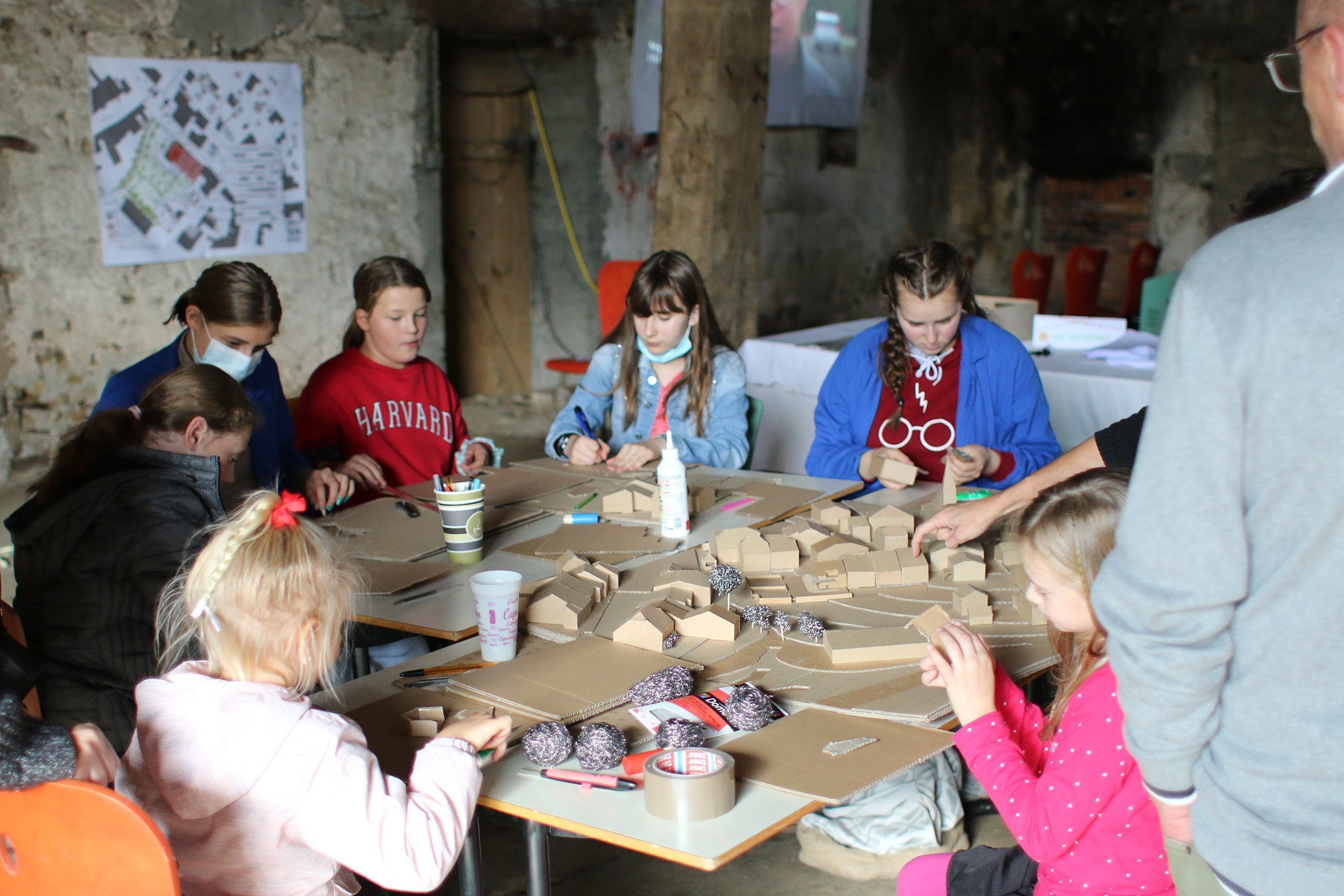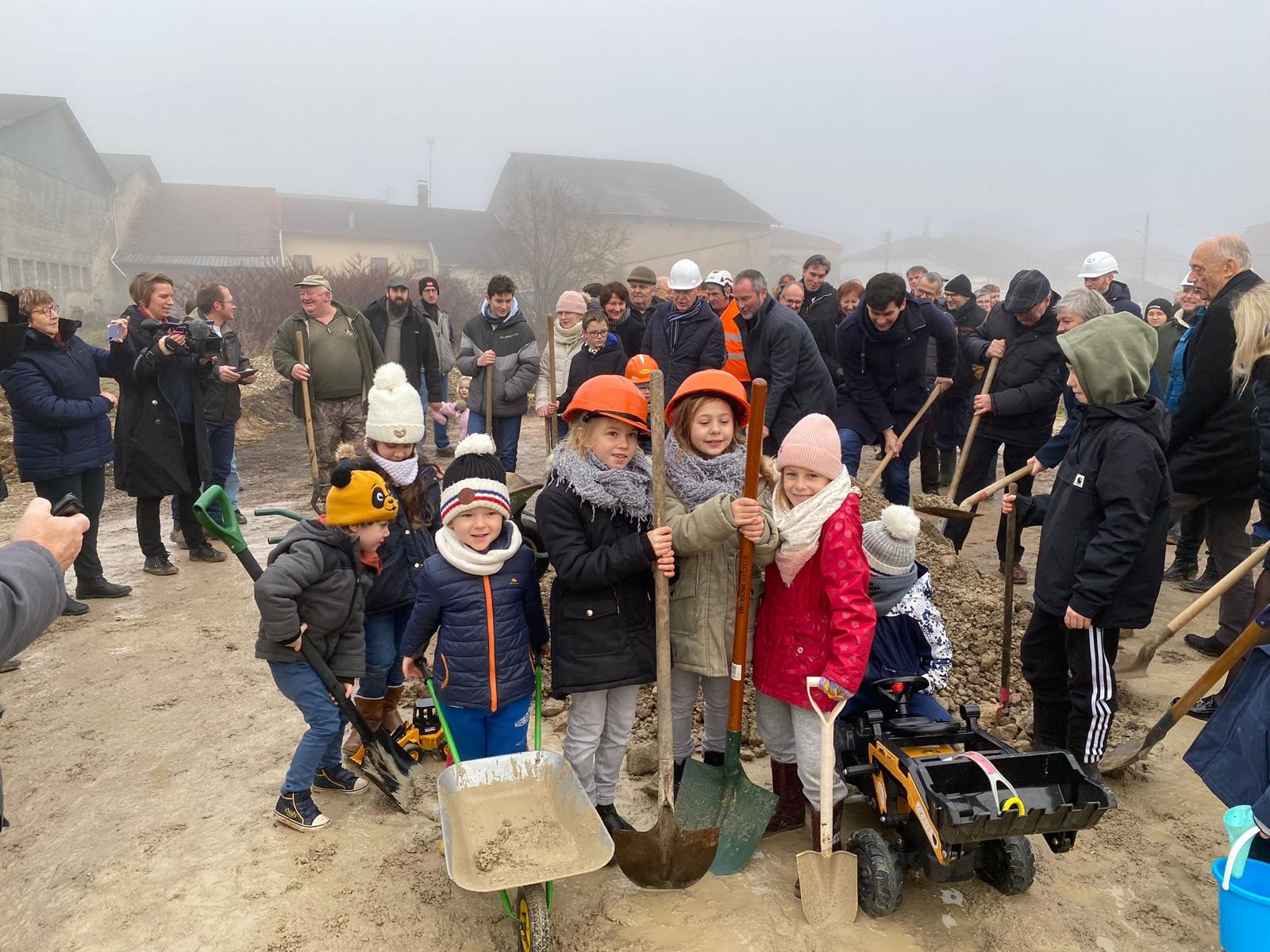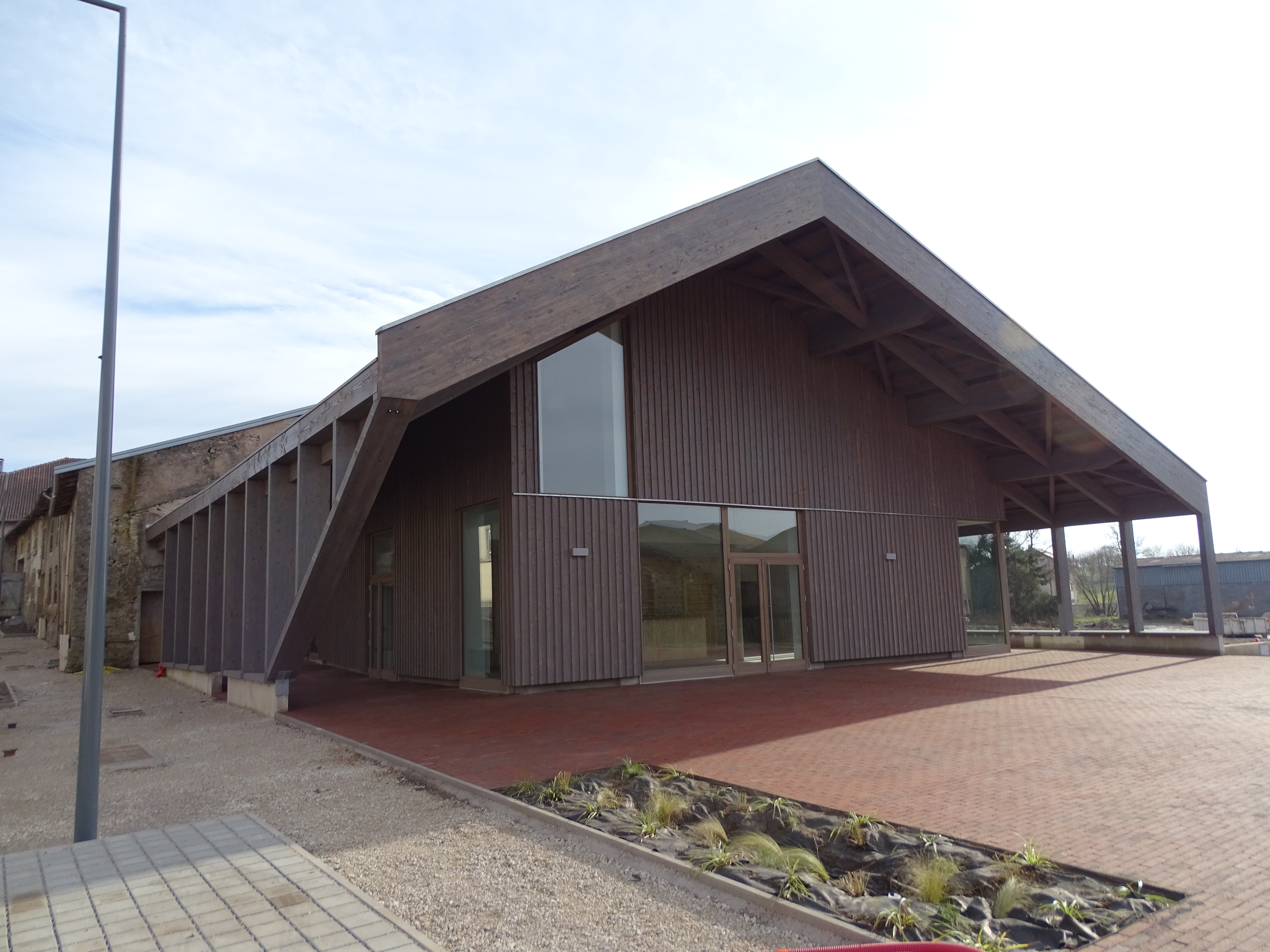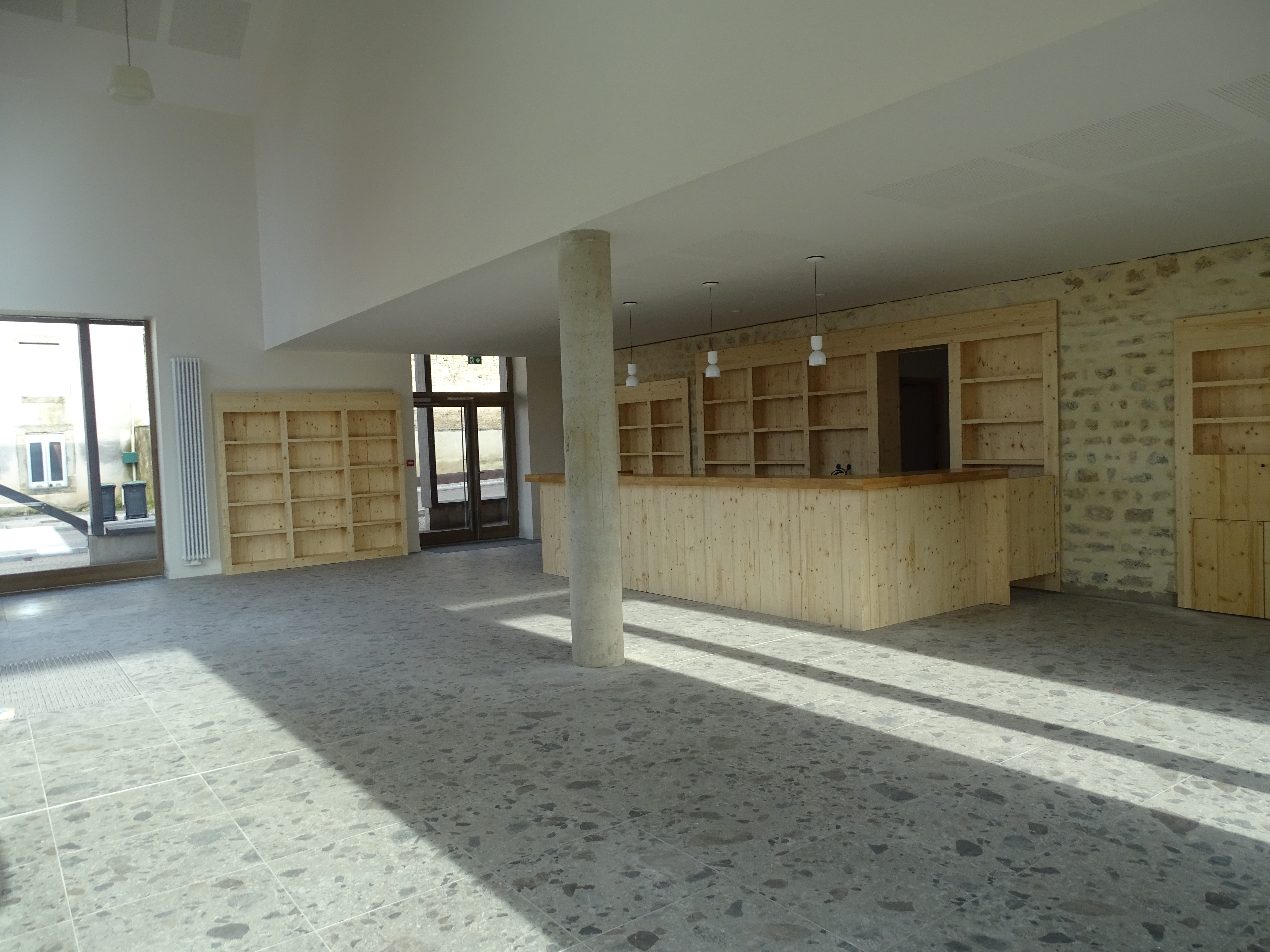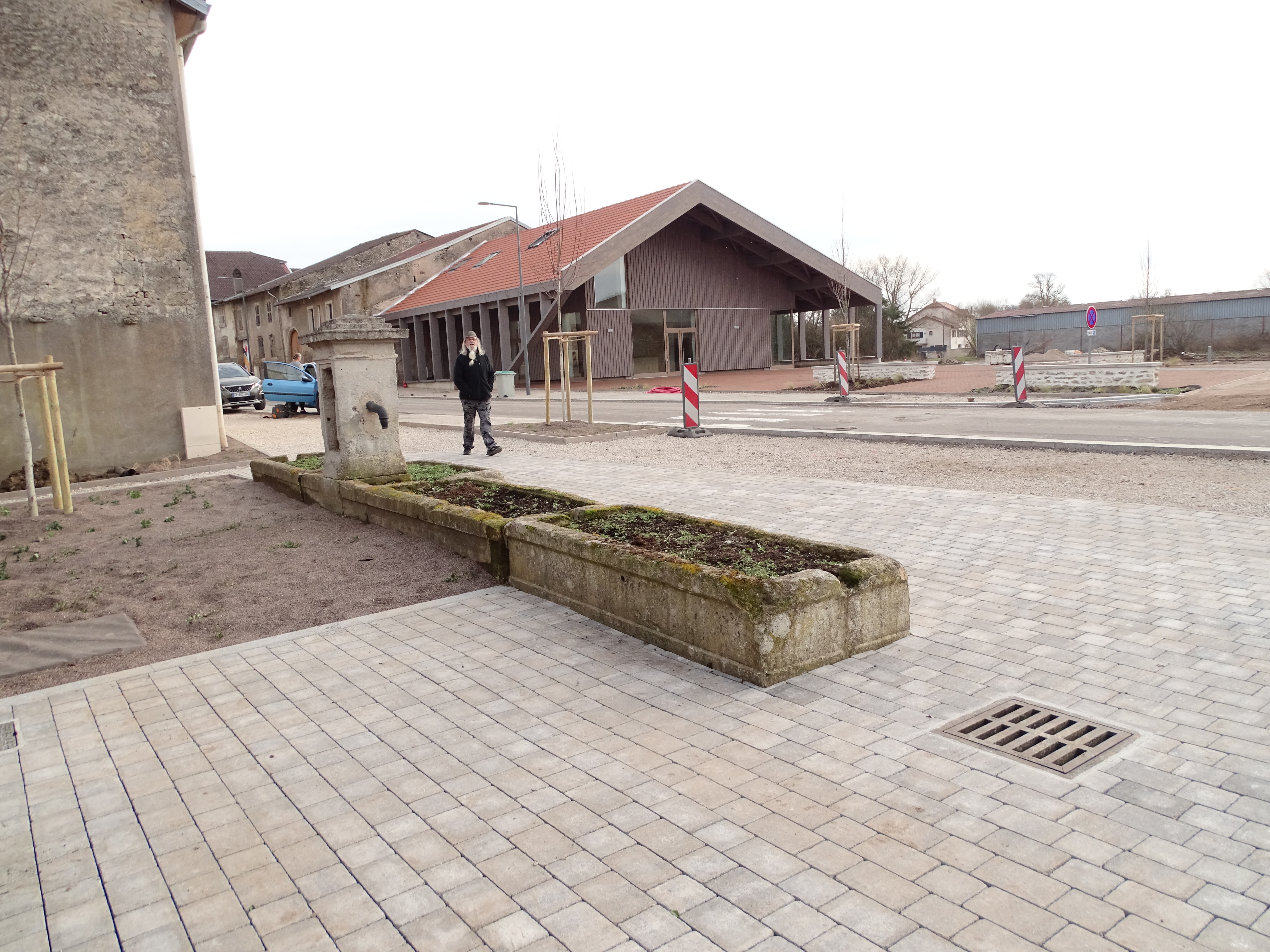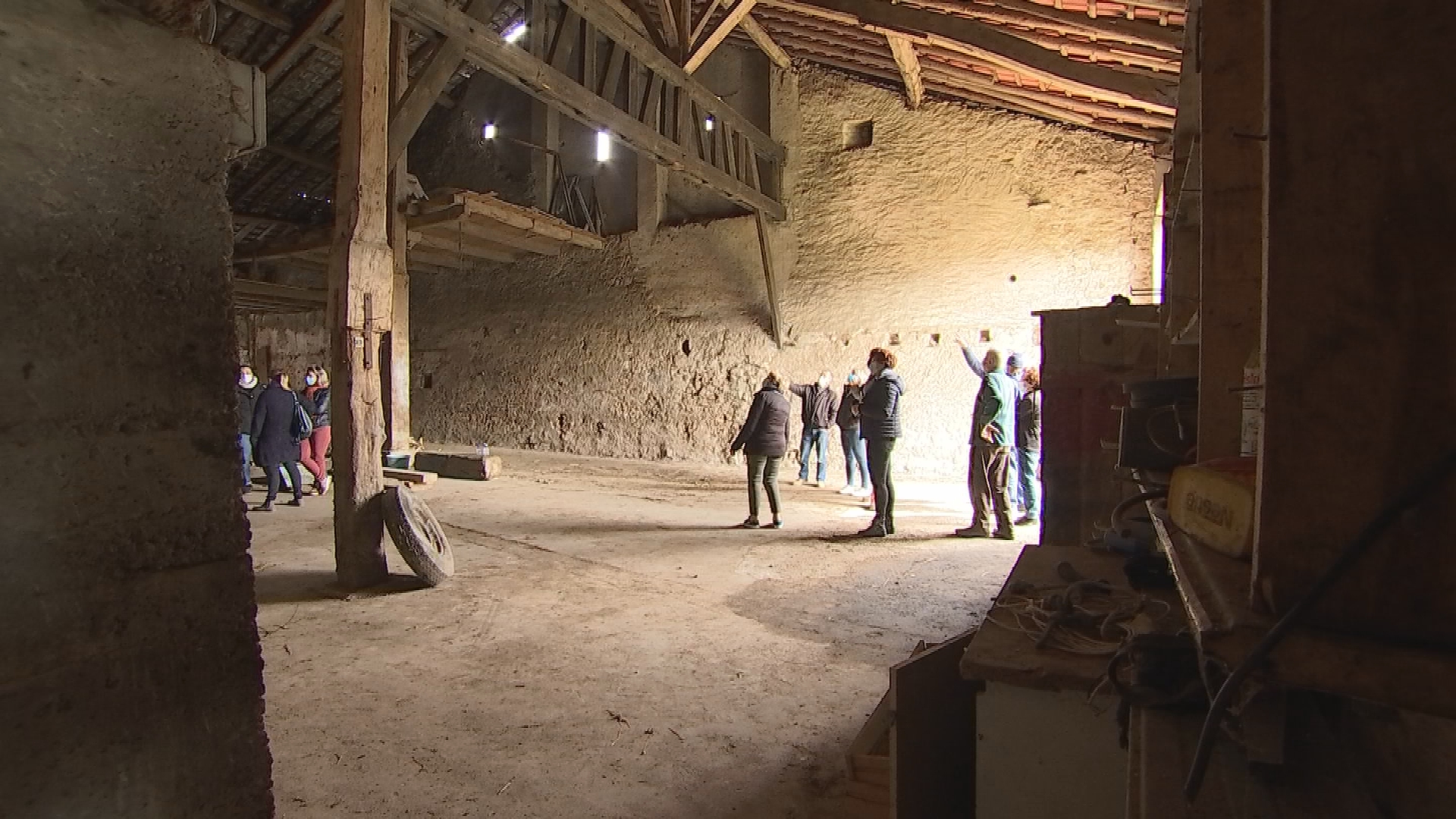Moriville dreams of its center
Village center revitalization
Since 2021, Moriville (Vosges) has been rehabilitating its village center: the construction of a multi-service café, a private microbrewery, a village square,
the requalification of the village crossing, a pedagogical garden-orchard, and the creation of rental housing with its residents at the heart of the process.
the requalification of the village crossing, a pedagogical garden-orchard, and the creation of rental housing with its residents at the heart of the process.
France
6 Grande rue 88330 MORIVILLE
Early initiative
Yes
Yes
Yes
No
No
88313: Moriville (FR)
Moriville, with 453 inhabitants. However, the village lacks attractiveness due to the presence, in the heart of the village, of a row of seven adjoining houses that have been abandoned for over 40 years. In addition to the insecurity caused by these buildings, most of which are in imminent danger of collapse, the heavily trafficked road further increases the risks. This situation negatively impacts the quality of life for residents, who cannot move around safely. Furthermore, there is no structured public space, no more shops, and too few rental housing options.
After acquiring the deteriorated buildings in 2021, the «Moriville Dreams of Its Center» project represents an opportunity to revitalize the village, enhance its attractiveness, and improve residents’ quality of life. The municipal team has launched a collaborative process with the residents. From 2021 to 2024, around a hundred Moriville residents have actively participated in shaping a shared vision for the future.
Several key needs have emerged to improve their quality of life while ensuring the preservation of the village’s heritage and rural identity:
- Creating a local shop with essential services and activities to strengthen social ties
- Redesigning structured, safe, and green public spaces
- Renovating old buildings to create accessible housing
- Encouraging and supporting private economic initiatives
Decisions Made :
- Construction of a multi-service café-restaurant (with housing for the manager), offering: a café and restaurant area, a bread depot, a grocery section, a parcel pick-up point, a community space, a digital access point, and event activities
- Creation of a village square with landscaped areas and parking spaces
- Development of an orchard garden
- Transfer of one of the buildings for the creation of a microbrewery and a tourist lodge
- Renovation of two buildings into housing
- Redevelopment of the village’s main road
After acquiring the deteriorated buildings in 2021, the «Moriville Dreams of Its Center» project represents an opportunity to revitalize the village, enhance its attractiveness, and improve residents’ quality of life. The municipal team has launched a collaborative process with the residents. From 2021 to 2024, around a hundred Moriville residents have actively participated in shaping a shared vision for the future.
Several key needs have emerged to improve their quality of life while ensuring the preservation of the village’s heritage and rural identity:
- Creating a local shop with essential services and activities to strengthen social ties
- Redesigning structured, safe, and green public spaces
- Renovating old buildings to create accessible housing
- Encouraging and supporting private economic initiatives
Decisions Made :
- Construction of a multi-service café-restaurant (with housing for the manager), offering: a café and restaurant area, a bread depot, a grocery section, a parcel pick-up point, a community space, a digital access point, and event activities
- Creation of a village square with landscaped areas and parking spaces
- Development of an orchard garden
- Transfer of one of the buildings for the creation of a microbrewery and a tourist lodge
- Renovation of two buildings into housing
- Redevelopment of the village’s main road
Revitalization of the village center
Economy and trade
Live and do together
Collective intelligence
Heritage
The sustainability approach in this project goes beyond the use of wood, as most of the materials used throughout the building and village square are of natural origin. This ensures healthy spaces, free from VOCs and toxic particles. Energy production and consumption were also central concerns. The designers opted for the most suitable and energy-efficient heating system—a pellet boiler—and an optimized heat distribution method. Moreover, the building's thermal envelope has been designed for high performance, minimizing energy needs.
The project was developed within a circular economy framework. The primary goal was to preserve and rehabilitate existing farm structures. Four farm buildings, which were in a state of
ruin, had to be dismantled due to their advanced deterioration. A material reuse assessment was carried out by the association Remise. The reintegration-focused company Reval Prest carefully sorted the salvaged materials by category to either reuse them on-site or reintegrate them into their network.
The wood used in the project is a locally sourced bio-based material from the Grand Est region, complemented by the reuse of stone blocks from the deconstructed farms. The old tiles were crushed and repurposed as mulch for green spaces. Some timber elements were reused as barriers for future parking areas. The remaining materials were made available to the local community or contributed to a regional materials bank.
This project is exemplary because it proves to residents that construction using bio-based materials is possible even within budget constraints. Inspired by this initiative, several locals have started restoring the village’s built heritage. Other municipalities are also closely following Moriville’s project with keen interest.
The project was developed within a circular economy framework. The primary goal was to preserve and rehabilitate existing farm structures. Four farm buildings, which were in a state of
ruin, had to be dismantled due to their advanced deterioration. A material reuse assessment was carried out by the association Remise. The reintegration-focused company Reval Prest carefully sorted the salvaged materials by category to either reuse them on-site or reintegrate them into their network.
The wood used in the project is a locally sourced bio-based material from the Grand Est region, complemented by the reuse of stone blocks from the deconstructed farms. The old tiles were crushed and repurposed as mulch for green spaces. Some timber elements were reused as barriers for future parking areas. The remaining materials were made available to the local community or contributed to a regional materials bank.
This project is exemplary because it proves to residents that construction using bio-based materials is possible even within budget constraints. Inspired by this initiative, several locals have started restoring the village’s built heritage. Other municipalities are also closely following Moriville’s project with keen interest.
This project takes the existing built environment into account and integrates harmoniously into the urban fabric. To create this new focal point for the village, it is necessary to deconstruct several existing, dilapidated farm buildings. In order to maintain and continue the characteristic rural architectural typology, it was essential to design a structure with familiar volumes that reflect the local identity while asserting a contemporary vision for the future—blending in while standing out.
The building adopts the archetypal form of Lorraine farmhouses, distinguished by a deep main structure and a steeply pitched roof. The goal was not to introduce an ex-nihilo, contextless construction that might visually overpower the surrounding homes. Instead, the design draws inspiration from existing volumes, traditional materials, and construction methods, as well as the village’s overall atmosphere, reinterpreting them within a contemporary building suited to its public function and widely open onto the future square. Both the new building and the sunken square will serve as a visual landmark along the main street, creating a breathing space within the dense urban fabric.
Wood has been prioritized through the use of slender porticoes that rhythmically recreate the aesthetic of traditional Vosges arcades. These elements elegantly shelter pedestrians from the weather while inviting them into the space. The entrances to the restaurant, bar, grocery store, and parcel pickup point are all accessible via this newly established, iconic promenade.
Initially, many residents were skeptical about creating an architecture that both respected traditional design principles and honored local culture. Through this project, they have rediscovered forgotten craftsmanship and techniques while embracing a modern architectural vision.
The building adopts the archetypal form of Lorraine farmhouses, distinguished by a deep main structure and a steeply pitched roof. The goal was not to introduce an ex-nihilo, contextless construction that might visually overpower the surrounding homes. Instead, the design draws inspiration from existing volumes, traditional materials, and construction methods, as well as the village’s overall atmosphere, reinterpreting them within a contemporary building suited to its public function and widely open onto the future square. Both the new building and the sunken square will serve as a visual landmark along the main street, creating a breathing space within the dense urban fabric.
Wood has been prioritized through the use of slender porticoes that rhythmically recreate the aesthetic of traditional Vosges arcades. These elements elegantly shelter pedestrians from the weather while inviting them into the space. The entrances to the restaurant, bar, grocery store, and parcel pickup point are all accessible via this newly established, iconic promenade.
Initially, many residents were skeptical about creating an architecture that both respected traditional design principles and honored local culture. Through this project, they have rediscovered forgotten craftsmanship and techniques while embracing a modern architectural vision.
The approach is inclusive, first and foremost, because the participatory workshops brought together people of all age groups: seniors, young couples, teenagers, and younger children. The activities were tailored to the audience, allowing everyone to share their dreams and needs. The approach is also intergenerational, as the meetings intentionally mixed different age groups. The project grows as people listen to one another and, in doing so, grow themselves. Nearly ten
workshops have already taken place—an incredible achievement. One-third of the population feels involved and is taking action!
The approach is inclusive because it has brought together people from different backgrounds, cultures, and social origins. Several proposals reflect this vision: social housing for the elderly, local shops, and community spaces to strengthen social ties. For a rural village of 400 inhabitants, this is no small feat.
The approach is also inclusive as it will engage schools through the creation of an educational orchard, where residents and children—guided by the association Les Croqueurs de Pommes—will plant apple trees. The Institut Médico-Éducatif in Châtel-sur-Moselle could also be involved, offering children and teenagers with disabilities the opportunity to participate in planting and educational activities. Some parents have even requested that the café host discussions on parenting.
The approach is inclusive because the municipality has chosen to involve social enterprises in the construction of certain structures, including demolition, material sorting, and planting.
Such an initiative fosters innovative and unifying projects while primarily addressing the needs of the village and its residents. Coming together to create a shared project strengthens intergenerational bonds and builds an inclusive, collective social experience.
workshops have already taken place—an incredible achievement. One-third of the population feels involved and is taking action!
The approach is inclusive because it has brought together people from different backgrounds, cultures, and social origins. Several proposals reflect this vision: social housing for the elderly, local shops, and community spaces to strengthen social ties. For a rural village of 400 inhabitants, this is no small feat.
The approach is also inclusive as it will engage schools through the creation of an educational orchard, where residents and children—guided by the association Les Croqueurs de Pommes—will plant apple trees. The Institut Médico-Éducatif in Châtel-sur-Moselle could also be involved, offering children and teenagers with disabilities the opportunity to participate in planting and educational activities. Some parents have even requested that the café host discussions on parenting.
The approach is inclusive because the municipality has chosen to involve social enterprises in the construction of certain structures, including demolition, material sorting, and planting.
Such an initiative fosters innovative and unifying projects while primarily addressing the needs of the village and its residents. Coming together to create a shared project strengthens intergenerational bonds and builds an inclusive, collective social experience.
Given the complexity of the project, the municipality has launched a programming study, entrusted to a group of urban planners and a consultancy firm, with the mission of developing the project in collaboration with the residents. Over the course of three years, around ten participatory sessions have been organized—and they are still ongoing! Moriville is experiencing the power of collective intelligence, bringing together many residents. This approach, which combines ideas, resources, and skills from residents, local associations, elected officials, and economic players, has led to innovative and sustainable solutions to today’s challenges.
Thanks to this participatory process, several innovative and unifying projects—whether public, private, or community-based—have emerged. Most importantly, it has helped address the needs of Moriville’s residents and the surrounding region. The sense of belonging to the village has been strengthened, uniting the population around a shared project within a framework of participatory democracy. At a time of major challenges, our project, «Moriville Dreams of Its Center,» also fosters local engagement, allowing residents to take an active role in a project with environmental, economic, and social dimensions.
«The enthusiasm of all participants—residents and various local authorities—has generated numerous ideas. It was a wise decision to involve the community in this large-scale project that directly affects them. Trusting people has shown that when the population believes in a project, institutions believe in it too and actively commit to making it a success—much like a ‘living system’ at work.»
Testimonial from Sébastien Vonau, creator of a microbrewery (production, sales, tasting, discovery tours), a shop, and a guesthouse (tourist lodge) in the new village center.
Thanks to this participatory process, several innovative and unifying projects—whether public, private, or community-based—have emerged. Most importantly, it has helped address the needs of Moriville’s residents and the surrounding region. The sense of belonging to the village has been strengthened, uniting the population around a shared project within a framework of participatory democracy. At a time of major challenges, our project, «Moriville Dreams of Its Center,» also fosters local engagement, allowing residents to take an active role in a project with environmental, economic, and social dimensions.
«The enthusiasm of all participants—residents and various local authorities—has generated numerous ideas. It was a wise decision to involve the community in this large-scale project that directly affects them. Trusting people has shown that when the population believes in a project, institutions believe in it too and actively commit to making it a success—much like a ‘living system’ at work.»
Testimonial from Sébastien Vonau, creator of a microbrewery (production, sales, tasting, discovery tours), a shop, and a guesthouse (tourist lodge) in the new village center.
The Moriville Project: A Multi-Partner Initiative with a Shared Political Vision
From the outset, the Moriville project has brought together numerous partners, thanks to a multi-partner approach and a shared political vision. First and foremost, the Epinal Urban Community and the CAUE des Vosges (Council for Architecture, Urban Planning, and Environment of the Vosges Department) have provided strong support to the municipality, offering technical expertise and guidance.
The French State, through the DDT (Departmental Directorate of Territories) and the ANCT (National Agency for Territorial Cohesion), has accompanied the project by contributing its expertise and participating in steering committees for two years.
In July 2021, the municipality signed the «Rural Built Heritage Renewal Agreement» (between the Municipality, the Epinal Urban Community, and the State). This initiative aims to revitalize and renovate rural built heritage, breathing new life into these spaces while preserving their character and authenticity. The goal is to sustain or attract new residents in rural areas facing demographic decline.
The French State has also provided significant financial support, notably through «France Relance / Fonds Friche», «DETR-DSIL», and «AAP Commerce Rural» programs.
Other financial supporters include the Grand Est Region, the Vosges Department, the Epinal Urban Community, and the Rhin-Meuse Water Agency.
Since the beginning of the project in 2021, the above-mentioned partners—along with Members of Parliament, Senators, mayors from neighboring municipalities, consular chambers, and associations—have been actively involved, offering valuable insights and support to help drive the project forward over time.
From the outset, the Moriville project has brought together numerous partners, thanks to a multi-partner approach and a shared political vision. First and foremost, the Epinal Urban Community and the CAUE des Vosges (Council for Architecture, Urban Planning, and Environment of the Vosges Department) have provided strong support to the municipality, offering technical expertise and guidance.
The French State, through the DDT (Departmental Directorate of Territories) and the ANCT (National Agency for Territorial Cohesion), has accompanied the project by contributing its expertise and participating in steering committees for two years.
In July 2021, the municipality signed the «Rural Built Heritage Renewal Agreement» (between the Municipality, the Epinal Urban Community, and the State). This initiative aims to revitalize and renovate rural built heritage, breathing new life into these spaces while preserving their character and authenticity. The goal is to sustain or attract new residents in rural areas facing demographic decline.
The French State has also provided significant financial support, notably through «France Relance / Fonds Friche», «DETR-DSIL», and «AAP Commerce Rural» programs.
Other financial supporters include the Grand Est Region, the Vosges Department, the Epinal Urban Community, and the Rhin-Meuse Water Agency.
Since the beginning of the project in 2021, the above-mentioned partners—along with Members of Parliament, Senators, mayors from neighboring municipalities, consular chambers, and associations—have been actively involved, offering valuable insights and support to help drive the project forward over time.
The revitalization project involves a wide range of disciplines: architecture, rural landscape, real estate programming, river and brownfield renaturation, history and rural heritage, mobility, local economies, and short supply chains.
The participatory approach allowed residents to understand, take action, and dream. It also enabled stakeholders and experts from various fields to meet and engage in a dynamic process.
Architects, urban planners, and landscape designers worked together in multidisciplinary teams with an integrated participatory approach. These professionals also collaborated with real estate planners from the Greater Epinal urban community and the department’s Council for Architecture, Urban Planning, and Environment (CAUE). Most importantly, they engaged with key players in the local economy: young speech therapists looking for office space, a brewer hoping to start a business, and a baker considering the best location for their shop.
Local heritage and history were championed by passionate residents and local historians who shared insights into the village’s past and traditional building materials. The CAUE also played a significant role in this aspect.
Mobility and daily uses were discussed with those directly affected: the residents. They highlighted the project’s potential as a key mobility hub. The café is located on a highly visible road, and hiking trails could start from there. The urban community proposed installing electric rental bikes on-site, and the future parking area might become a designated meeting point for carpoolers. Time will tell.
Through numerous workshops, residents expressed their needs. Alongside elected officials and stakeholders, they proposed innovative uses: a communal oven for baking bread and pizzas, a shared apple press for making juice, a space for outdoor concerts and film screenings, a grocery store, a bread depot, and a community hub for parenting support.
The participatory approach allowed residents to understand, take action, and dream. It also enabled stakeholders and experts from various fields to meet and engage in a dynamic process.
Architects, urban planners, and landscape designers worked together in multidisciplinary teams with an integrated participatory approach. These professionals also collaborated with real estate planners from the Greater Epinal urban community and the department’s Council for Architecture, Urban Planning, and Environment (CAUE). Most importantly, they engaged with key players in the local economy: young speech therapists looking for office space, a brewer hoping to start a business, and a baker considering the best location for their shop.
Local heritage and history were championed by passionate residents and local historians who shared insights into the village’s past and traditional building materials. The CAUE also played a significant role in this aspect.
Mobility and daily uses were discussed with those directly affected: the residents. They highlighted the project’s potential as a key mobility hub. The café is located on a highly visible road, and hiking trails could start from there. The urban community proposed installing electric rental bikes on-site, and the future parking area might become a designated meeting point for carpoolers. Time will tell.
Through numerous workshops, residents expressed their needs. Alongside elected officials and stakeholders, they proposed innovative uses: a communal oven for baking bread and pizzas, a shared apple press for making juice, a space for outdoor concerts and film screenings, a grocery store, a bread depot, and a community hub for parenting support.
This initiative focuses on:
•
The circular economy through the reuse of materials,
•
A participatory and co-construction approach,
•
The ecological restoration of an abandoned rural site,
•
The rehabilitation of a degraded built heritage (which residents previously struggled to recognize as valuable),
•
The creation of a central, multifunctional space for the village.
However, the truly innovative aspect of this initiative lies in its ability to attract new projects. Around the café-grocery store project, other initiatives and dynamics have emerged:
•
A private investor leveraged the momentum to establish a microbrewery in a nearby farm,
•
A new village square is being envisioned next to the bar,
•
A group of villagers, with the support of an association, is creating an educational orchard and restoring a neglected plot,
•
The redevelopment of the village’s main thoroughfare,
•
The renovation of two additional farmhouses to provide suitable housing,
•
The purchase of an old cheese dairy located across from the bar,
•
The revitalization of the village as a whole.
A Remarkable Rural Initiative
Another major innovative feature of this initiative—perhaps the most significant—is that it is happening in a village of just 400 inhabitants. A third of the population actively participated in the workshops. This rural project has gained widespread recognition and support from political stakeholders at all levels (State, Department, Member of Parliament, Senator, President of the Metropolitan Area, and local elected officials).
•
The circular economy through the reuse of materials,
•
A participatory and co-construction approach,
•
The ecological restoration of an abandoned rural site,
•
The rehabilitation of a degraded built heritage (which residents previously struggled to recognize as valuable),
•
The creation of a central, multifunctional space for the village.
However, the truly innovative aspect of this initiative lies in its ability to attract new projects. Around the café-grocery store project, other initiatives and dynamics have emerged:
•
A private investor leveraged the momentum to establish a microbrewery in a nearby farm,
•
A new village square is being envisioned next to the bar,
•
A group of villagers, with the support of an association, is creating an educational orchard and restoring a neglected plot,
•
The redevelopment of the village’s main thoroughfare,
•
The renovation of two additional farmhouses to provide suitable housing,
•
The purchase of an old cheese dairy located across from the bar,
•
The revitalization of the village as a whole.
A Remarkable Rural Initiative
Another major innovative feature of this initiative—perhaps the most significant—is that it is happening in a village of just 400 inhabitants. A third of the population actively participated in the workshops. This rural project has gained widespread recognition and support from political stakeholders at all levels (State, Department, Member of Parliament, Senator, President of the Metropolitan Area, and local elected officials).
A shared diagnosis involving residents, local stakeholders, and partners
Collective identification of program elements to define emerging needs
Testing project scenarios and themes collectively
Assessing the economic and financial feasibility of one or more scenarios with professionals (architects, landscape designers, planners), local elected officials (Épinal Urban Community, Department, Region, State), partners, and funders
Launching calls for projects to attract private investors
Phasing the operation over time based on partner commitments and municipal projects
Initiating the design and construction phases accordingly
Revitalizing rural areas and enhancing the attractiveness of a village require a large-scale effort focused on public consultation (surveys, polls, meetings, workshops…) as well as project communication (website, multiple videos, street interviews, social media, online and print press…). These efforts help raise awareness about the project and bring together collective energy.
Collective identification of program elements to define emerging needs
Testing project scenarios and themes collectively
Assessing the economic and financial feasibility of one or more scenarios with professionals (architects, landscape designers, planners), local elected officials (Épinal Urban Community, Department, Region, State), partners, and funders
Launching calls for projects to attract private investors
Phasing the operation over time based on partner commitments and municipal projects
Initiating the design and construction phases accordingly
Revitalizing rural areas and enhancing the attractiveness of a village require a large-scale effort focused on public consultation (surveys, polls, meetings, workshops…) as well as project communication (website, multiple videos, street interviews, social media, online and print press…). These efforts help raise awareness about the project and bring together collective energy.
The participatory, transparent, dynamic, and generous approach could be replicated in other rural areas. However, residents, stakeholders, partners, elected officials, and professionals often struggle to communicate with one another. Mediators and facilitators are essential to bringing these different players together and guiding them toward a collective, dynamic project.
To keep all stakeholders engaged, continuous communication is key—through films, social media, and regular updates—to ensure that the momentum never fades and that there is always an upcoming event or milestone to look forward to. This requires a real commitment to the initiative.
It is also crucial to talk about the project openly, meet a wide variety of stakeholders, and keep an open mind—anything is possible! The role of private initiatives should not be underestimated. Calls for projects from private actors remain an important aspect, as entrepreneurs bring forward needs that no one can truly anticipate in such initiatives. There must be a careful balance between financial sustainability and the flexibility to embrace unexpected, disruptive projects. Constant listening, encouragement, and support are necessary.
Overall, this type of project is energy-intensive and time-consuming. Rural elected officials often lack training and experience in managing such initiatives. There is a real need for European programs to train actors in developing these kinds of projects for rural areas!
To keep all stakeholders engaged, continuous communication is key—through films, social media, and regular updates—to ensure that the momentum never fades and that there is always an upcoming event or milestone to look forward to. This requires a real commitment to the initiative.
It is also crucial to talk about the project openly, meet a wide variety of stakeholders, and keep an open mind—anything is possible! The role of private initiatives should not be underestimated. Calls for projects from private actors remain an important aspect, as entrepreneurs bring forward needs that no one can truly anticipate in such initiatives. There must be a careful balance between financial sustainability and the flexibility to embrace unexpected, disruptive projects. Constant listening, encouragement, and support are necessary.
Overall, this type of project is energy-intensive and time-consuming. Rural elected officials often lack training and experience in managing such initiatives. There is a real need for European programs to train actors in developing these kinds of projects for rural areas!
Europe, Lorraine, and particularly the Vosges department are experiencing a severe demographic decline in rural areas, a trend that has accelerated since 2010. This phenomenon is accompanied by an aging population, the abandonment and deterioration of old buildings, and the disappearance of small businesses.
Moriville is a rural community facing these challenges, with degraded historical buildings and the loss of its local businesses.
Global development perspectives are primarily urban. Territories are becoming increasingly metropolitan. When rural areas are not entirely deserted or merely transited, they often find solutions in tourism or by hosting a secondary economy. However, we refuse to resign ourselves to this fate. Rural territories are "spaces of opportunity" for many people—not only farmers but also those with roots, networks, and cultural ties there. Rural areas can also provide refuge for the most vulnerable and serve as a space for the development of certain businesses.
Admittedly, the task is more difficult in these areas, as capital tends to flow toward more economically promising regions. This is why global public policies must take a proactive approach to support local initiatives like the one in Moriville.
Moriville’s initiative takes on the challenge of maintaining a controlled carbon footprint, contributing to the global effort toward sustainability. The project places circular economy principles and short supply chains at its core. It prioritizes the reuse of local materials—stone blocks, tiles, structural timber, locally sourced wood, and bio-based insulation. A controlled carbon footprint also involves revitalizing local commerce. A grocery store and a bread depot will provide nearby products, reducing the need for car travel. The initiative also promotes the use of electric bicycles to access the nearby train station.
Moriville is a rural community facing these challenges, with degraded historical buildings and the loss of its local businesses.
Global development perspectives are primarily urban. Territories are becoming increasingly metropolitan. When rural areas are not entirely deserted or merely transited, they often find solutions in tourism or by hosting a secondary economy. However, we refuse to resign ourselves to this fate. Rural territories are "spaces of opportunity" for many people—not only farmers but also those with roots, networks, and cultural ties there. Rural areas can also provide refuge for the most vulnerable and serve as a space for the development of certain businesses.
Admittedly, the task is more difficult in these areas, as capital tends to flow toward more economically promising regions. This is why global public policies must take a proactive approach to support local initiatives like the one in Moriville.
Moriville’s initiative takes on the challenge of maintaining a controlled carbon footprint, contributing to the global effort toward sustainability. The project places circular economy principles and short supply chains at its core. It prioritizes the reuse of local materials—stone blocks, tiles, structural timber, locally sourced wood, and bio-based insulation. A controlled carbon footprint also involves revitalizing local commerce. A grocery store and a bread depot will provide nearby products, reducing the need for car travel. The initiative also promotes the use of electric bicycles to access the nearby train station.
Completing the work on the multi-service café, recruiting and supporting managers to sustain commercial activity as part of the village project. Continuing to unite local stakeholders (connecting with local suppliers and producers, associations for support and event organization). Working in a tripartite manner with «managers - 1000 cafés - municipality.» Installing an electric bike station next to the café.
A pedagogical garden-orchard: planting fruit trees with residents and schools, creating a flower meadow, and a relaxation area. A residents’ collective, in collaboration with the association La Barbelouze and «Les Croqueurs de Pommes,» is currently being formed and will be responsible for managing and animating the space. The project includes the development of planted ditches, rural hedges, and nectar-producing plants. This intergenerational space will accommodate facilities such as a tree nursery, shared vegetable gardens, a community apple juice press, and educational activities for all generations of local residents. Installation of signage elements.
The village crossing has been redesigned to restore a rural and landscaped quality to Moriville. The creation of planted areas and green spaces continues, along with the integration of rainwater management through the use of permeable concrete for sidewalks and planted ditches.
Housing
The two preserved farmhouses are intended for the creation of around ten social and ecological housing units. Since 2021, several operators and social housing providers have been contacted. However, due to the current economic climate, the initially identified partners have withdrawn. The revitalization of Moriville, supported by the Epinal agglomeration community, is ongoing, and other options are being explored (sale with specific requirements, contact with new operators, potential municipal investment in this housing project, etc.).
A pedagogical garden-orchard: planting fruit trees with residents and schools, creating a flower meadow, and a relaxation area. A residents’ collective, in collaboration with the association La Barbelouze and «Les Croqueurs de Pommes,» is currently being formed and will be responsible for managing and animating the space. The project includes the development of planted ditches, rural hedges, and nectar-producing plants. This intergenerational space will accommodate facilities such as a tree nursery, shared vegetable gardens, a community apple juice press, and educational activities for all generations of local residents. Installation of signage elements.
The village crossing has been redesigned to restore a rural and landscaped quality to Moriville. The creation of planted areas and green spaces continues, along with the integration of rainwater management through the use of permeable concrete for sidewalks and planted ditches.
Housing
The two preserved farmhouses are intended for the creation of around ten social and ecological housing units. Since 2021, several operators and social housing providers have been contacted. However, due to the current economic climate, the initially identified partners have withdrawn. The revitalization of Moriville, supported by the Epinal agglomeration community, is ongoing, and other options are being explored (sale with specific requirements, contact with new operators, potential municipal investment in this housing project, etc.).

